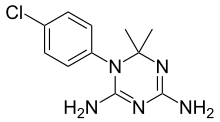Cycloguanil
 | |
 | |
| Clinical data | |
|---|---|
| ATC code | |
| Identifiers | |
| |
JSmol) | |
| |
| |
| (verify) | |
Cycloguanil is a
Malarone), cycloguanil is in fact antagonistic to the effects of atovaquone, suggesting that, unlike cycloguanil, proguanil may have an alternative mechanism of antimalarial action besides dihydrofolate reductase inhibition.[3]
Although cycloguanil is not currently in general use as an antimalarial, the continuing development of resistance to current antimalarial drugs has led to renewed interest in studying the use of cycloguanil in combination with other drugs.[4]
Synthesis

The reaction between 4-chloroaniline [106-47-8] (1) and
dicyandiamide
(aka 2-cyanoguanidine) [461-58-5 ] (2) gives 4-chlorophenylbiguanide [5304-59-6] (3). The condensation of this immediately with acetone to form the aminal cycloguanil (4).
References
- PMID 10348748.
- PMID 6385887.
- PMID 15228254.
- PMID 8363372.
- ^ Modest, Edward J. (1956). "Chemical and Biological Studies on 1,2-Dihydro-s-triazines. II. Three-Component Synthesis". The Journal of Organic Chemistry 21 (1): 1–13. doi:10.1021/jo01107a001.
- ^ Modest, Edward J.; Levine, Philip. (1956). "Chemical and Biological Studies on 1,2-Dihydro-s-triazines. III. Two-Component Synthesis". The Journal of Organic Chemistry. 21(1): 14–20. doi:10.1021/jo01107a002.
- ^ Carrington, H. C.; Crowther, A. F.; Stacey, G. J. (1954). "Synthetic antimalarials. Part XLIX. The structure and synthesis of the dihydrotriazine metabolite of proguanil". Journal of the Chemical Society (Resumed): 1017. doi:10.1039/jr9540001017.
- ^ Modest, Edward J.; Foley, George E.; Pechet, Maurice M.; Farber, Sidney (1952). "A SERIES OF NEW, BIOLOGICALLY SIGNIFICANT DIHYDROTRIAZINES". Journal of the American Chemical Society. 74 (3): 855–856. doi:10.1021/ja01123a532.
- ^ Loo, Ti Li (1954). "1-p-Chlorophenyl-2,4-diamino-6,6-dimethyl-1,6-dihydro-1,3,5- triazine". Journal of the American Chemical Society. 76 (20): 5096–5099. doi:10.1021/ja01649a026.
- ^ Edward J. Modest, U.S. patent 2,900,385 (1959 to Children s Cancer Research Foundation).
- ^ Donald F. Worth, U.S. patent 3,074,947 (1963 to Parke).
